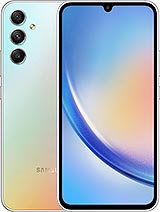Samsung Galaxy A25 review

The competition
At the time of writing, a base 6GB/128GB Galaxy A25 will set you back about $250/€285/£250/INR 27,000, and the higher-end 8GB/256GB tier will set you back $399/€330/INR 30,000. That's a competitive price bracket with plenty of viable alternatives.

While we are still not certain what Samsung is cooking up for the Galaxy A35, last year's Galaxy A34 has fallen in price nicely. You can get a base 6GB/128GB unit for around $250/€250/£190/INR 25,500. Of course, since the A34 is technically "last gen" and came out with Android 13 and One UI 5.1, you have a shorter support window remaining from the four years of major updates and five years of security patches Samsung is promising.
In terms of upgrades over the A25, ther A34 is getting you a proper IP67 ingress protection, 4K video capture on the selfie camera and a slightly more powerful Dimensity 1080 chipset. The other specs are kind of a wash across the two devices. You are even giving up the 3.5mm audio jack that the A25 has. Still, the A34 might be a better fit for you personally.



Samsung Galaxy A34 • Xiaomi Poco X6 • Xiaomi Poco M6 Pro
We have plenty of models to consider from the latest crop of Xiaomi devices. There is the ever-popular Redmi Note series and the vanilla Redmi Note 13 in particular. It currently goes for a bit less than the Galaxy A25 and offers pretty comparable specs. Its Dimensity 6080 is a bit more powerful, but you do have to settle for 1080p video capture despite the phone's ample 108MP main camera resolution.
Enter the Xiaomi Poco X6. It seems like the most reasonable alternative to the Galaxy A25. Granted, it does seem to cost slightly more, but you are getting a better, brighter and HDR-capable 12-bit AMOLED display, a more powerful Snapdragon 7s Gen 2 chipset, IP54 ingress protection and Gorilla Glass Victus, 256GB base storage and 8GB of RAM and notably faster 67W charging on the 5,100 mAh onboard battery, to name just a few points. If you have just a bit more to spend, you could also go up to the Poco X6 Pro with its faster UFS 4.0 storage and better overall battery life, according to our testing.
If you are looking to save some money instead, there is the Poco M6 Pro 4G, which is kind of identical to the Redmi Note 13 Pro 4G just a bit cheaper. Next to the Galaxy A25, it has a pretty comparable display and a slightly less powerful chipset. You will have to live with 1080p video capture, but you won't be giving up on other niceties like the stereo speaker setup, 3.5mm audio jack, the NFC or the FM radio. As a bonus, the Poco M6 Pro also offers faster 67W charging and official IP54 ingress protection.
Our verdict
Last year, Samsung made a rather perplexing choice with the Galaxy A24 by only introducing it in a 4G/LTE version. All the while the A34 was 5G and even the A15 had a 5G variant. This is no longer the case with the new Galaxy A25, and that's not the only sensible upgrade introduced to the formula.
The move from 90Hz to 120Hz refresh rate might be relatively small, but it is meaningful and helps the phone feel smother and more responsive overall. You could probably eek some longer battery life runtimes out of it with the high refresh rate disabled so it's up to you to make that choice.
The jump up from the MediaTek Helio G99 to the Exynos 1280 might not be colossal in terms of raw performance either, but beyond the already mentioned 5G connectivity, it also brings 4K video recording to the Galaxy A25, which is another small but significant update.
The new stereo speaker setup also counts big time in our books. It might not shine in any particular manner over the competition, but it is still miles better than the single speaker offered on the Galaxy A24.

All of these small updates pile up and arguably place the Galaxy A25 closer than ever to Galaxy A3X territory regarding features. Other than the upgrades, the Galaxy A25 still offers a solid build, now with a slightly tweaked design, which we found to offer a more comfortable grip. Both the battery life and performance are dependable, and the same can mostly be said about the camera setup. Well, at least in daylight. Low-light photography is a bit of a letdown, though still not bad enough to be a dealbreaker.
We would have loved to see a proper ingress protection rating on the Galaxy A25 like its bigger brothers get, but perhaps next year. We really don't see anything major in the Galaxy A25 to complain about. It is a solid Samsung device with all that entails for a reasonable price, and we are sure it will enjoy good popularity.
Pros
- Attractive & sturdy design.
- The Super AMOLED display now does 120Hz.
- Stereo speakers with good quality.
- Latest Android and One UI.
- Good performance for this price range and great thermal behavior.
- Great photo and video quality now with 4K video capture, lossless 2x zoom, great selfie photos&videos.
- 5G, NFC, microSD.
Cons
- No charger in the box.
- Still no official ingress protection rating.
- No automatic refresh rate switching and no HDR support.
- Video stabilization is only available in 1080p.
- Pretty poor all-around low-light camera performance.
- Virtual proximity sensor.
Reader comments
- C4RB0N3T4
- 07 Apr 2025
- raQ
I'm living in a country with poor connection and i don't have any problems calling or using the internet with this phone
- yonda
- 07 Apr 2025
- NHZ
the phone is life
- Anonymous
- 01 Apr 2025
- uu4
The new A series sucks so bad. All except the A56. But even it is too pricey right now.

